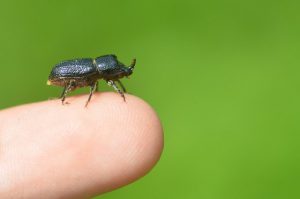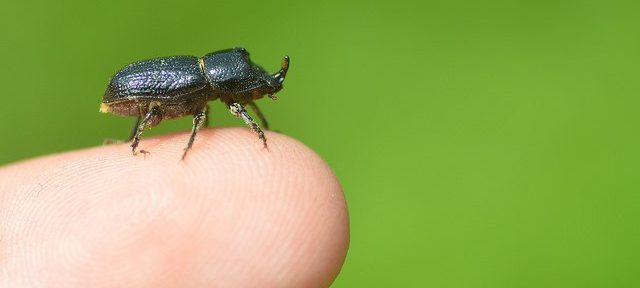
I knew from reading previous trainees blog posts that this time of year would get rather busy, however I didn’t appreciate quite how busy it would be! My feet have barely touched the ground and I have learnt an incredible amount. Hopefully I can give you a small flavour of this in this blog post.
Dead Wood Beetles
My work at Blenheim Palace has really taken off now, I didn’t really catch that much in the first month of my vane traps being out, however in the last few checks of the traps there has been a lot more in there for me to identify and start to build up a picture of the beetles living within the dead trees, an area that no one has looked at properly! Checking traps may sound like a rather easy survey technique, all I have to do is change over a bottle, right?! Well the traps are quite often inside a dead tree, 3 metres of so up and can be challenging to reach by a ladder, which means that I have to have someone come with me each time to assist me. This is great though as it gives me an opportunity to show lots more people how amazing dead trees are for wildlife, something that I knew nothing about before this traineeship! I have been slowly working through and identifying the dead wood associated beetles that I have found on site. This is rather challenging as there are dead wood species in all sorts of beetle families.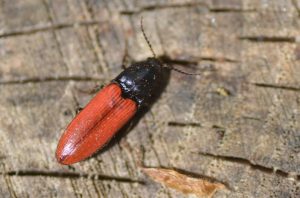 But I find this challenge rather exciting and I am learning lots every day. I have also been wandering around Blenheim beating the hawthorn and dead wood, this is because I only have 16 traps up and there are over a 1000 veteran oaks within the area and the adult beetles of many dead wood species visit hawthorn blossom. By using this technique I have picked up around 15 species which I haven’t recorded in my traps yet. I will also check umbellifers later on in the year. Buglife and Natural England are working on a HLF bid to conserve dead wood species (not just invertebrates), so I have been lucky enough to be able to tag along to some site visits there, including a lovely trip to Little Doward on the Welsh border which was just beautiful and gave me a chance to see a different site that is great for invertebrates and think about how they manage their site.
But I find this challenge rather exciting and I am learning lots every day. I have also been wandering around Blenheim beating the hawthorn and dead wood, this is because I only have 16 traps up and there are over a 1000 veteran oaks within the area and the adult beetles of many dead wood species visit hawthorn blossom. By using this technique I have picked up around 15 species which I haven’t recorded in my traps yet. I will also check umbellifers later on in the year. Buglife and Natural England are working on a HLF bid to conserve dead wood species (not just invertebrates), so I have been lucky enough to be able to tag along to some site visits there, including a lovely trip to Little Doward on the Welsh border which was just beautiful and gave me a chance to see a different site that is great for invertebrates and think about how they manage their site.
Fenland Invertebrates
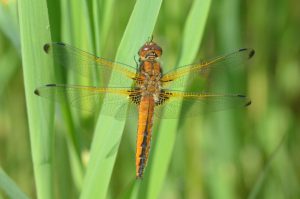 As I moved to Peterborough for this traineeship, I wanted to explore some of the special habitats here and expand my knowledge of the special invertebrates that they support. Around Peterborough is the Great Fen, an amazing project looking to restore large areas of fenland habitat. At the heart of this is Woodwalton Fen National Nature Reserve. I have been surveying this site to look at the invertebrates there. I have pitfall traps out in the reed beds here, which are cut at different rates. I have 4 pitfall traps in each of the 3 reed beds that have different cutting regimes. I have been identifying the ground and rove beetles from these traps and this is turning up some great fenland specialists.
As I moved to Peterborough for this traineeship, I wanted to explore some of the special habitats here and expand my knowledge of the special invertebrates that they support. Around Peterborough is the Great Fen, an amazing project looking to restore large areas of fenland habitat. At the heart of this is Woodwalton Fen National Nature Reserve. I have been surveying this site to look at the invertebrates there. I have pitfall traps out in the reed beds here, which are cut at different rates. I have 4 pitfall traps in each of the 3 reed beds that have different cutting regimes. I have been identifying the ground and rove beetles from these traps and this is turning up some great fenland specialists.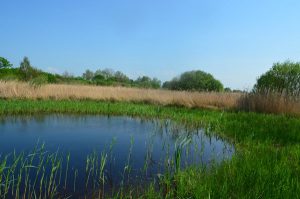 These species have been recorded on site before, but this pitfall trapping is helping to indicate abundance and therefore informing management of the reedbeds for these species. While I am on the site I have been looking at other, non beetle, species and am blown away by some of the species there such as scarce chasers (a type of dragonfly) and the silver colonel soldier fly which hadn’t been recorded on the site since 1949 until I came along and looked for it.
These species have been recorded on site before, but this pitfall trapping is helping to indicate abundance and therefore informing management of the reedbeds for these species. While I am on the site I have been looking at other, non beetle, species and am blown away by some of the species there such as scarce chasers (a type of dragonfly) and the silver colonel soldier fly which hadn’t been recorded on the site since 1949 until I came along and looked for it.
Outreach
I have been also working on my outreach skills in the last month or so, not something that comes naturally to me by any means! I ran a Bughunt at the Green Backyard in Peterborough which was good fun. The Green Backyard is a community initiative that 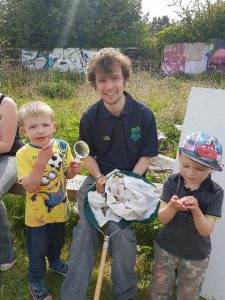 brings greenspace to people living in central Peterborough that may not be able to go out into the wider countryside. It was a great event and lots of children and adults searched in the pond and meadow areas for invertebrates with me. It was great to be able to show them that the invertebrates make the newts in the pond look boring! I was also invited along the ‘Experts Day’ at the Three Hagges Wood Meadow in Yorkshire. It was great to be able to see this project again, which will eventually create an amazing habitat for dead wood invertebrates in hundreds of years, from a field that was used to grow barley a few years ago. I also have an article in the next issue of Natur cymru which is rather exciting. My piece is on dead wood invertebrates, focussing on the specialists that Wales holds!
brings greenspace to people living in central Peterborough that may not be able to go out into the wider countryside. It was a great event and lots of children and adults searched in the pond and meadow areas for invertebrates with me. It was great to be able to show them that the invertebrates make the newts in the pond look boring! I was also invited along the ‘Experts Day’ at the Three Hagges Wood Meadow in Yorkshire. It was great to be able to see this project again, which will eventually create an amazing habitat for dead wood invertebrates in hundreds of years, from a field that was used to grow barley a few years ago. I also have an article in the next issue of Natur cymru which is rather exciting. My piece is on dead wood invertebrates, focussing on the specialists that Wales holds!
Stay tuned for next months blog post to hear about the exciting things I have been getting up to!
Ryan
Don’t forget that you can follow my progress on the TCV Natural Talent Twitter account and my personal Twitter account. You can also found out more about Esmee Fairbairn who kindly fund the Natural Talent traineeships, and Buglife and Natural England who host me.

